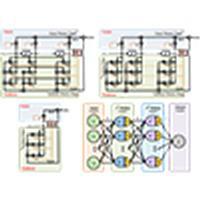当前位置:
X-MOL 学术
›
Opt. Express
›
论文详情
Our official English website, www.x-mol.net, welcomes your feedback! (Note: you will need to create a separate account there.)
Comparison of nonlinear equalizers for high-speed visible light communication utilizing silicon substrate phosphorescent white LED.
Optics Express ( IF 3.8 ) Pub Date : 2020-01-20 , DOI: 10.1364/oe.383775 Yingjun Zhou , Yiran Wei , Fangchen Hu , Jian Hu , Yiheng Zhao , Jianli Zhang , Fengyi Jiang , Nan Chi
Optics Express ( IF 3.8 ) Pub Date : 2020-01-20 , DOI: 10.1364/oe.383775 Yingjun Zhou , Yiran Wei , Fangchen Hu , Jian Hu , Yiheng Zhao , Jianli Zhang , Fengyi Jiang , Nan Chi

|
Compared with multicolor-chip integrated white LEDs, phosphor-based white LEDs are more attractive for daily illumination due to lower cost and complexity, and thus they are preferable for future commercial use of visible light communication (VLC) systems. However, the application of phosphorescent white LEDs has a lower data rate than multicolor-chip integrated LEDs because of severe nonlinear impairments and limited bandwidth caused by the slow-responding phosphor. In this paper, for the first time we propose to employ phosphorescent white LEDs based on silicon substrate with adaptive bit-loading discrete multitone (DMT) modulation and a memoryless polynomial based nonlinear equalizer to achieve a high-speed VLC system. We also present a comprehensive comparison among nonlinear equalizers based on the Volterra series model, memory polynomial model, memoryless polynomial model and deep neural network (DNN) with experimental results utilizing a silicon substrate phosphorescent white LED, and provide detailed suggestions on how to choose the most suitable nonlinear mitigation scheme considering different practical conditions and the tradeoff between complexity and performance. Beyond 3.00 Gb/s DMT VLC transmission over 1-m indoor free space is successfully demonstrated with bit error rate (BER) under the 7% forward error correction (FEC) limit of 3.8×10-3. As far as we know, this is the highest data rate ever reported for VLC systems based on a single high-power phosphorescent white LED.
中文翻译:

利用硅基板磷光白色LED进行高速可见光通信的非线性均衡器的比较。
与多色芯片集成白光LED相比,基于磷光体的白光LED具有较低的成本和复杂性,因此在日常照明中更具吸引力,因此,它们对于可见光通信(VLC)系统的未来商业应用而言更为可取。但是,磷光白光LED的应用数据速率比多色芯片集成LED低,这是因为严重的非线性损伤和缓慢响应的磷光体造成的带宽有限。在本文中,我们首次建议采用基于硅基板的磷光白光LED,具有自适应位负载离散多音(DMT)调制和基于无记忆多项式的非线性均衡器,以实现高速VLC系统。我们还提出了基于Volterra级数模型的非线性均衡器之间的全面比较,记忆多项式模型,无记忆多项式模型和深度神经网络(DNN),利用硅基板磷光白光LED的实验结果,并针对如何根据不同的实际条件以及复杂性和性能之间的权衡选择最合适的非线性缓解方案提供了详细建议。在3.8×10-3的7%前向纠错(FEC)限制下,误码率(BER)成功地证明了在1-m室内自由空间中超过3.00 Gb / s DMT VLC传输。据我们所知,这是有史以来基于单个高功率磷光白光LED的VLC系统的最高数据速率。并针对不同的实际条件以及复杂性与性能之间的折衷,提供了如何选择最合适的非线性缓解方案的详细建议。在3.8×10-3的7%前向纠错(FEC)限制下,误码率(BER)成功地证明了在1-m室内自由空间中超过3.00 Gb / s DMT VLC传输。据我们所知,这是有史以来基于单个高功率磷光白光LED的VLC系统的最高数据速率。并针对不同的实际条件以及复杂性和性能之间的折衷,提供了如何选择最合适的非线性缓解方案的详细建议。在3.8×10-3的7%前向纠错(FEC)限制下,误码率(BER)成功地证明了在1-m室内自由空间中超过3.00 Gb / s DMT VLC传输。据我们所知,这是有史以来基于单个高功率磷光白光LED的VLC系统的最高数据速率。
更新日期:2020-01-17
中文翻译:

利用硅基板磷光白色LED进行高速可见光通信的非线性均衡器的比较。
与多色芯片集成白光LED相比,基于磷光体的白光LED具有较低的成本和复杂性,因此在日常照明中更具吸引力,因此,它们对于可见光通信(VLC)系统的未来商业应用而言更为可取。但是,磷光白光LED的应用数据速率比多色芯片集成LED低,这是因为严重的非线性损伤和缓慢响应的磷光体造成的带宽有限。在本文中,我们首次建议采用基于硅基板的磷光白光LED,具有自适应位负载离散多音(DMT)调制和基于无记忆多项式的非线性均衡器,以实现高速VLC系统。我们还提出了基于Volterra级数模型的非线性均衡器之间的全面比较,记忆多项式模型,无记忆多项式模型和深度神经网络(DNN),利用硅基板磷光白光LED的实验结果,并针对如何根据不同的实际条件以及复杂性和性能之间的权衡选择最合适的非线性缓解方案提供了详细建议。在3.8×10-3的7%前向纠错(FEC)限制下,误码率(BER)成功地证明了在1-m室内自由空间中超过3.00 Gb / s DMT VLC传输。据我们所知,这是有史以来基于单个高功率磷光白光LED的VLC系统的最高数据速率。并针对不同的实际条件以及复杂性与性能之间的折衷,提供了如何选择最合适的非线性缓解方案的详细建议。在3.8×10-3的7%前向纠错(FEC)限制下,误码率(BER)成功地证明了在1-m室内自由空间中超过3.00 Gb / s DMT VLC传输。据我们所知,这是有史以来基于单个高功率磷光白光LED的VLC系统的最高数据速率。并针对不同的实际条件以及复杂性和性能之间的折衷,提供了如何选择最合适的非线性缓解方案的详细建议。在3.8×10-3的7%前向纠错(FEC)限制下,误码率(BER)成功地证明了在1-m室内自由空间中超过3.00 Gb / s DMT VLC传输。据我们所知,这是有史以来基于单个高功率磷光白光LED的VLC系统的最高数据速率。



























 京公网安备 11010802027423号
京公网安备 11010802027423号